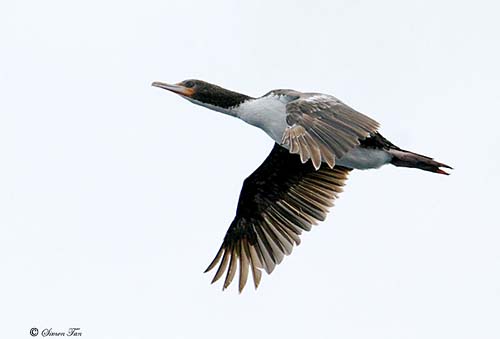
Fr: Cormoran des Chatham
Ang: Chatham Shag - Chatham Island Shag
All: Chathamscharbe
Esp: Cormorán de las Chatham
Ita: Cormorano delle Chatham
Nd: Onslows Aalscholver
Sd: Chathamskarv
Photographer:
Simon Tan
PBase Bird galleries
Text by Nicole Bouglouan
Sources:
HANDBOOK OF THE BIRDS OF THE WORLD vol 1 by Josep del Hoyo-Andrew Elliot-Jordi Sargatal - Lynx Edicions - ISBN: 8487334105
A Complete Guide to Antarctic Wildlife by Hadoram Shirihai and Illustrated by Brett Jarrett - Edited by Guy M. Kirwan - ALUL.A Press Oy, Finland - ISBN 9519894705
BirdLife International (BirdLife International)
Chatham Island and Pitt island Shag census 2011
Te Ara – The Encyclopedia of New Zealand
New Zealand birds and birding (Narena Olliver)
New Zealand bird status between 2008 and 2012
Page family Phalacrocoracidae
Summary cards
Chatham (Island) Shag
Leucocarbo onslowi
Suliformes Order – Phalacrocoracidae Family
INTRODUCTION:
The Chatham Shag is restricted to the Chatham Islands where it is the only “pink-footed” or “blue-eyed” shag of this island group. The small population estimated at 357 pairs in 2011, is affected by the usual threats, and no direct conservation management action has been made for this species which is currently studied in order to protect it in the future. However, as the coastal habitat is fenced, cattle cannot access to some colonies.
DESCRIPTION OF THE BIRD:
Biometrics:
Length: 63 cm
Weight: 2-2,5 kg
The adult has black-and-white plumage, with black head, hindneck, back, wings and tail. There is a white patch on the upperwing, forming a conspicuous white wingbar on the folded wings. In addition, we can see another white patch on the lower back, more visible in flight.
On the underparts, chin, throat, breast, belly and undertail-coverts are white, but the outer part of the thighs is black. The underwing is dark.
On the black head, we can see a fairly short, erectile crest. The dark reddish-brown eyes are surrounded by bright blue-purple eyering. The bare facial skin is dark purple with conspicuous orange-red caruncles or knobs. The gular pouch is mostly orange-red like the bare skin at base of the lower mandible and the gape. The rather long bill is greyish-brown with paler, mostly yellowish tip. Legs and feet are pink.
During the breeding season, there are some thin, white filoplumes on the neck sides, and above and behind the eye.
Outside the breeding season, it lacks the crest and the white filoplumes. The bare parts of the head are duller. The white patches of forewing and back are reduced or absent.
Both sexes are similar in plumage, but the male is slightly larger than the female.
The juvenile is browner, duller than adults. It lacks crest, caruncles and bright-coloured facial skin. On the wing, the lesser and median coverts and the scapulars have paler tips.

RANGE:
The Chatham Shag is endemic to the Chatham Island group. It breeds on several islands such as Chatham, Pitt, Rabbit and The Star Keys.
HABITAT:
The Chatham Shag breeds and roosts on rocky coastal headlands and small islands, usually on slopes and large cliff ledges.
It forages in coastal and inshore waters, at some kilometres from the shore.
Like the Pitt Island Shag, it also occurs on the brackish Te Whanga Lagoon where it breeds on the island within the lagoon, and forages in the southern part in deeper water.
CALLS AND SONGS: SOUNDS BY XENO-CANTO
The Chatham Shag male is noisy at colonies, giving repeated loud barking and ticking calls near the nest. The female usually utters soft puffing calls.
During the displays, the male utters a barking “heh-heh-heh” in gaping display, and a loud “borrr” as sexual advertisement.
BEHAVIOUR IN THE WILD:
The Chatham Shag feeds primarily on small fish (10-20 cm long) but it also takes squid, cuttlefish and octopus found in deeper waters.
Like other shags, it probably feeds by pursuit-diving.
This species is monogamous and colonial breeder, forming small monospecific colonies established on rocky headlands and offshore islets, and also on cliff ledges.
Little is known about the breeding behaviour, but we can suggest that the courtship displays enhance the bright head pattern, especially during the gape display.
The Chatham Shag is sedentary in the Chatham Islands, and it remains all year round within the coastal waters.
The flight is powerful with rapid and continuous wingbeats. The head is held lower than the body. It flies low over the water surface.
REPRODUCTION OF THIS SPECIES:
The laying occurs between September and November, but it can be variable. In the colony of Te Whanga Lagoon, the breeding season usually occurs three months earlier than in coastal colonies.
The nest is placed above the high tide mark on flat bare rock. It is made with grass and seaweeds, and the plant materials are held together with mud and excreta. A small territory is defended around the site.
The female lays 2-4 pale blue eggs with dark markings. Both adults share the incubation during about one month, by stints of equal length.
At hatching, the chicks are naked, but a smoky-brown down grows rapidly. They are fed by both parents by regurgitation. They fledge 4-6 weeks after hatching.
PROTECTION / THREATS / STATUS:
The Chatham Shag is threatened by the loss of its breeding habitat, stock disturbance, introduced predators, predation by gulls, and human persecution. Climate change also affects the food supply.
However, the largest colonies occur on predator-free islands.
There were 357 breeding pairs in 2011, equating to 714 mature individuals and about 1070 birds in total at 12 known breeding colonies. This population is decreasing.
The Chatham Shag is currently evaluated as Critically Endangered.